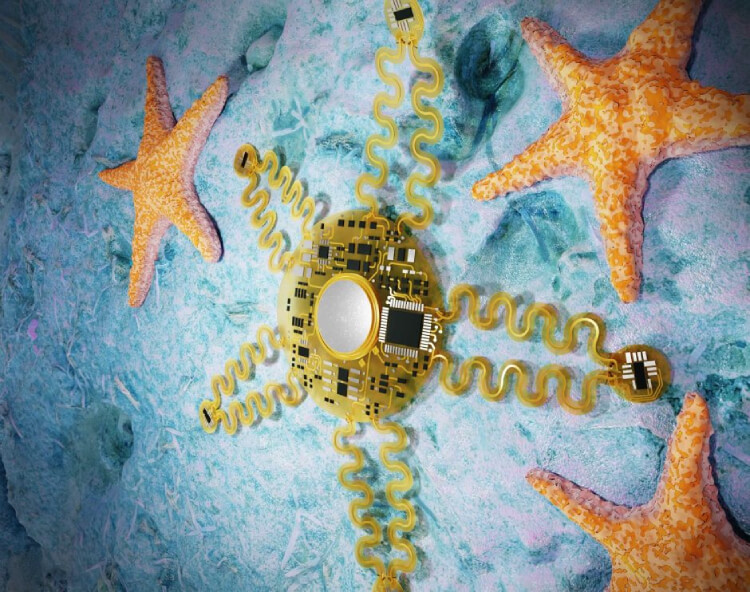Starfish-Shaped Wearable Heart Sensor Uses AI for Accuracy
Insights | 04-06-2025 | By Robin Mitchell

Key Takeaways:
- The University of Missouri has developed a starfish-inspired wearable device that detects heart problems with over 90% accuracy using AI-enhanced signal analysis.
- The five-arm structure improves data stability during movement, making it suitable for real-time, at-home heart health monitoring.
- Bluetooth integration supports remote monitoring by healthcare professionals, aligning with NHS decentralised care goals.
- Engineers are advancing breathable, skin-friendly materials to address long-term wearability and user comfort challenges.
As the demand for continuous, real-time health monitoring grows, wearable electronics have become a cornerstone of modern medical technology. Yet, these devices often fall short when it comes to flexibility, comfort, and diagnostic accuracy—particularly in the field of heart health. Addressing these challenges, researchers at the University of Missouri have developed an innovative wearable device that leverages a starfish-inspired design and AI-driven analytics to detect heart problems with over 90% accuracy.
What limitations do current wearables face, how does this new device work, and could it mark the beginning of a new era in personalised cardiac care?
The Challenges of Wearable Electronics in Heart Health Monitoring
Wearable electronics have surged in popularity over the last decade, driven by consumer interest in health tracking and the promise of personalised medical insights. Devices like smartwatches and fitness bands now commonly offer real-time data on metrics such as heart rate and blood oxygen levels, providing users with a constant stream of physiological information. I use such devices myself on a daily basis—not because they're perfect, but because they offer valuable insight into cardiac health that was previously difficult to access outside a clinical setting.
However, as useful as they are, today's wearable health monitors come with a number of technical and ergonomic limitations that prevent them from reaching their full potential.
Rigid Designs Undermine Comfort in Continuous Wear Applications
First, despite being labelled "wearable," most of these devices are far from truly seamless. They can be worn, certainly, but comfort and natural mobility are still serious challenges. This is largely due to the rigid nature of the electronic components they contain. These devices rely on printed circuit boards and sensors housed in stiff enclosures, which often restrict flexibility and limit how organically the device can move with the body. For something that's supposed to be worn 24/7, the engineering focus has clearly prioritised function over comfort.
In terms of sensing capability, the limitations become even more apparent—especially when it comes to heart health. While wrist-based monitors can estimate heart rate using optical sensors (like PPG), they fall short when it comes to more advanced diagnostics, such as measuring electrical cardiac activity (ECG or EKG). Proper heart monitoring often requires measurements taken across the chest or at multiple points on the body. A single device strapped to the wrist simply can't capture that kind of spatial data with the necessary fidelity.
What we're left with is a category of devices that are often uncomfortable to wear for long periods, limited in their diagnostic accuracy, and, despite mass production, still relatively expensive for what they offer.
The promise of wearable health tech is real, but we're still a long way from truly integrated, high-fidelity, low-cost systems. Moving forward, solving these challenges will require innovation in flexible electronics, better sensor integration, and a shift away from the one-size-fits-all design philosophy that currently dominates the market.
Wearable Tech Detects Heart Problems with Over 90% Accuracy, Utilises Starfish Design
Heart monitoring wearables have often struggled to balance accuracy with convenience. Traditional smartwatches and chest straps either lack sensor depth or suffer from motion-related noise. This newly developed device, however, tackles both by mimicking a biological form designed for dynamic stability, thereby delivering enhanced reliability without sacrificing comfort or portability.
Recently, a team of researchers from the University of Missouri has successfully developed a wearable device that can detect heart problems with an accuracy of over 90%. The device, designed to resemble a starfish, utilises AI technology to analyse heart signals and provide real-time health insights. This breakthrough in wearable technology could potentially change at-home monitoring and provide individuals with a convenient tool for tracking their heart health.
Starfish-Inspired Stability Enhances Motion-Resilient Monitoring
One of the most notable advantages of the starfish-inspired design is its ability to maintain stable contact with the skin, even during movement. This structural innovation draws directly from how starfish coordinate their limbs to maintain balance, providing a mechanical analogue that improves data quality during motion-intensive activities. By increasing sensor contact points across the chest, the device reduces artefacts and enhances signal clarity, which is a critical factor for accurate at-home cardiac assessments.
The device consists of five arms equipped with sensors that capture both electrical and mechanical heart signals. Unlike traditional wearable devices that often focus on a single signal, the starfish-shaped device simultaneously captures multiple signals, providing a more comprehensive picture of heart health. The use of AI technology further enhances the device's capabilities, allowing it to filter out movement-related disruptions and accurately identify potential heart problems.
The underlying AI system is trained on an extensive dataset comprising both healthy and abnormal heart signals, enabling it to distinguish early indicators of cardiac anomalies. By employing real-time signal interpretation, the device avoids false positives often encountered in motion-heavy environments, making it more reliable than traditional single-sensor devices.
According to the researchers, the AI-based approach has been shown to correctly identify heart conditions more than 9 out of 10 times. The device also features Bluetooth capabilities, enabling remote monitoring by doctors, which can be particularly beneficial for individuals who require ongoing monitoring between medical visits. Furthermore, the device is capable of wireless charging, eliminating the need for frequent removal for recharging.
Bluetooth Connectivity Bridges the Gap in Telehealth Cardiac Care
Another key feature supporting usability is remote physician access to the collected data via Bluetooth synchronisation with a smartphone app. This connectivity allows healthcare providers to track patient trends without requiring in-person appointments, aligning well with current telehealth standards. Such functionality aligns with NHS goals for decentralised monitoring, particularly for individuals with chronic cardiac conditions.
While the device has shown promising results, the researchers are also working to improve its long-term wearability. One of the primary challenges faced by wearable devices is skin irritation, which can occur when worn for extended periods. To address this issue, the researchers are exploring the development of breathable, skin-friendly materials that can enhance comfort and reduce skin irritation. The team has been working on improving this material for several years and hopes to integrate it into future versions of the device.
Wearability remains a major hurdle in the long-term adoption of medical-grade wearables. The research team is currently exploring the use of breathable polymers that resist irritation during continuous skin contact. By focusing on material science alongside signal fidelity, they aim to develop a device suitable for sensitive skin types and long-term use—an essential component for ensuring user adherence in non-clinical settings.
Is There a Solution for Monitoring Heart Health from One Point?
As it stands, accurately monitoring heart health from a single point remains an elusive goal. Our current understanding of the human body and its electrical systems tells us that capturing meaningful data on heart activity requires at least two points to get a reliable reading. Any sensor designed to measure electrical heart activity needs to span a certain distance, which means it's inherently limited by the size and flexibility of the device.
Right now, that means any wearable sensor that can monitor your heart's electrical signals in a practical, real-time way is going to be bulky and cumbersome. This isn't just a design challenge; it's a fundamental limitation of the way we interact with our bodies' electrical signals.
Smart Textiles Offer a Path Forward Beyond Rigid Wearables
But all hope isn't lost. One possible solution on the horizon is the development of smart textiles, such as vests or shirts embedded with sensors that could stretch across the chest to capture that essential distance. Imagine a piece of clothing that could monitor heart activity, body temperature, sweat levels, and physical movement all at once. It could collect a wealth of data points without relying on traditional rigid electronics, integrating seamlessly into daily life.
The real question, however, is whether such a technology would ever make its way into mainstream use. Fashion is deeply personal and varied, and getting people to wear something that isn't just functional but also comfortable is a whole different challenge. People explore their own style, and a bulky, sensor-laden vest might not be something everyone is willing to embrace, especially when it comes to balancing aesthetics with functionality.
Balancing Wearability and Adoption in Personal Health Tech
That being said, there's a clear path for smart textiles to become integral for certain groups. Individuals at higher risk for heart conditions or those needing continuous monitoring could greatly benefit from such a garment, which could provide constant, unobtrusive feedback. If developed properly, this could lead to an era where we catch heart problems early and potentially prevent heart attacks before they even occur.
It may sound optimistic, but with the right advances in materials science, wearable tech, and user-centred design, the future might not be too far off. Imagine a world where your clothing not only keeps you warm or stylish but also monitors your health in real-time, catching issues long before they become emergencies.
In the end, while this type of tech may not be a one-size-fits-all solution, it certainly represents the next frontier in health monitoring. If we can crack the comfort, usability, and versatility of smart textiles, we may find ourselves in a world where heart disease is far less of a threat. And that's a future worth working toward.

